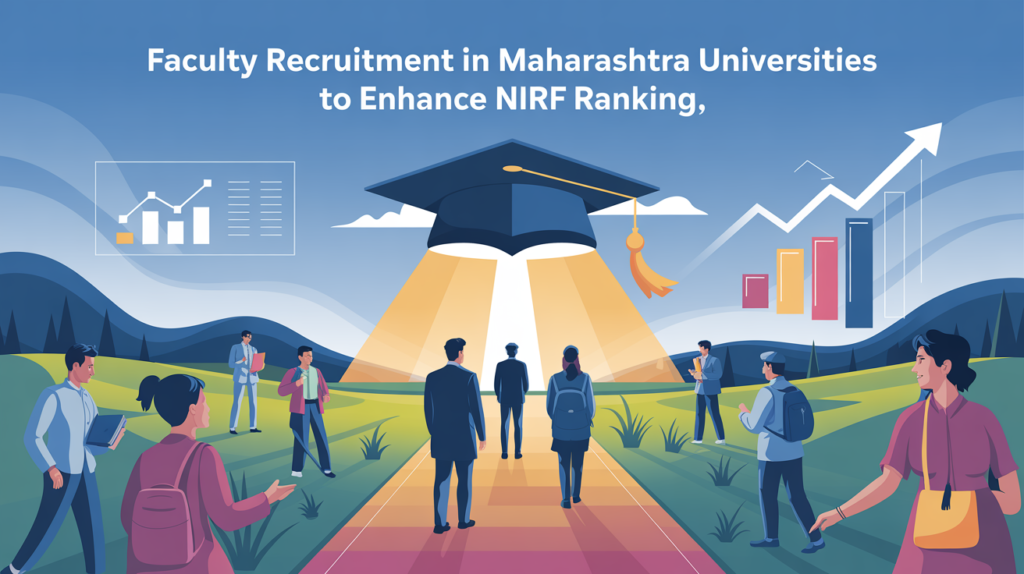The announcement of Faculty Recruitment in Maharashtra Universities to Improve NIRF Ranking has generated widespread attention in India’s education sector. With over 11,000 faculty vacancies set to be filled, Maharashtra’s government is taking a crucial step toward strengthening teaching quality, boosting research, and enhancing student learning experiences.
This bold move comes after concerns that unfilled posts and poor teacher–student ratios were dragging down the National Institutional Ranking Framework (NIRF) performance of universities in the state. By focusing on Faculty Recruitment in Maharashtra Universities to Improve NIRF Ranking, policymakers aim to not only improve scores but also raise global competitiveness.
📚 Why Faculty Recruitment Matters for NIRF Ranking
The NIRF Ranking evaluates institutions based on parameters such as teaching quality, research output, graduation outcomes, outreach, and perception. Faculty play a central role in almost all these indicators.
Here’s why Faculty Recruitment in Maharashtra Universities to Improve NIRF Ranking is so important:
Improved Teacher–Student Ratio – Vacancies in teaching posts lead to larger class sizes, reducing personal attention.
Enhanced Research Output – More faculty means greater contributions to publications, patents, and projects.
Better Academic Reputation – Skilled professors attract collaborations and recognition.
Higher Student Satisfaction – Engaged and well-trained faculty improve classroom learning and mentorship.
🔑 7 Key Insights on Faculty Recruitment in Maharashtra Universities to Improve NIRF Ranking
11,000+ Vacancies to Be Filled
The Maharashtra government has pledged to fill over 11,000 faculty positions, addressing a long-standing shortage across public universities.Focus on Quality Appointments
Recruitment will emphasize merit-based selection to ensure that only the most qualified candidates enter the system.Boost to Research & Innovation
With more faculty, universities can increase publications, collaborate internationally, and secure more research funding.Positive Impact on Teacher–Student Ratio
Many state universities have faced a ratio exceeding UGC norms. Recruitment will bring this closer to recommended levels.Enhanced NIRF Ranking Scores
Parameters like Teaching, Learning & Resources (TLR) and Research & Professional Practices (RP) will see significant improvement.Support for Rural & Regional Campuses
Faculty recruitment will also benefit universities in smaller cities, ensuring balanced educational growth across the state.Contribution to Global Competitiveness
Strengthened universities will gain visibility in international rankings, enhancing India’s soft power in education.
📊 Table: Impact of Faculty Recruitment on NIRF Ranking Parameters
| NIRF Parameter | Current Challenge | Expected Improvement After Recruitment |
|---|---|---|
| Teaching, Learning & Resources | High teacher–student ratio | Improved classroom interaction |
| Research & Professional Practices | Limited research publications | Higher output through faculty strength |
| Graduation Outcomes | Lack of mentoring and guidance | Better career support for students |
| Outreach & Inclusivity | Low student engagement in rural areas | Wider participation with more faculty |
| Perception | Declining reputation | Stronger global and national image |
🎯 Impact on Students
The Faculty Recruitment in Maharashtra Universities to Improve NIRF Ranking is not just about numbers—it directly impacts students:
Better Learning Outcomes – With more professors, students will receive personalized attention.
Expanded Research Opportunities – UG and PG students will have mentors guiding them in projects and internships.
Skill Development – Recruitment ensures diverse faculty expertise in modern and interdisciplinary fields.
Improved Career Readiness – Better guidance translates to stronger placement records.
🌍 National and Global Relevance
The Faculty Recruitment in Maharashtra Universities to Improve NIRF Ranking aligns India with global higher education practices. Worldwide, leading universities invest heavily in academic staff to maintain high rankings and attract international students.
With India aiming to become a global education hub under the National Education Policy (NEP) 2020, such initiatives are critical for achieving international recognition and ensuring students receive world-class learning.
🏫 Challenges Ahead
While Faculty Recruitment in Maharashtra Universities to Improve NIRF Ranking is a positive step, challenges remain:
Ensuring Timely Appointments – Recruitment drives must avoid delays caused by bureaucracy.
Maintaining Quality Standards – The rush to fill posts should not compromise the quality of appointments.
Retaining Talent – Universities must create attractive work environments to prevent faculty migration.
Continuous Training – Faculty need upskilling in technology, pedagogy, and research methods.
✅ Final Thoughts
The decision on Faculty Recruitment in Maharashtra Universities to Improve NIRF Ranking marks a milestone in India’s pursuit of quality education. By filling vacancies and strengthening teaching staff, the Maharashtra government is addressing both academic and reputational gaps.
If implemented effectively, this initiative can:
Improve student outcomes,
Boost research contributions, and
Elevate India’s higher education system to global standards.
Ultimately, Faculty Recruitment in Maharashtra Universities to Improve NIRF Ranking is not just about climbing charts—it’s about building stronger, smarter, and more confident graduates for the future.
Q1. What is the main aim of Faculty Recruitment in Maharashtra Universities to Improve NIRF Ranking?
The aim is to fill vacancies, improve teaching quality, and enhance the NIRF scores of state universities.
Q2. How many faculty vacancies will be filled?
Over 11,000 positions across various universities in Maharashtra.
Q3. How will recruitment improve NIRF ranking?
It will strengthen parameters like Teaching, Research, Graduation Outcomes, and Reputation.
Q4. What challenges may arise in this recruitment drive?
Delays in appointments, ensuring quality hiring, and retaining talented faculty.
Q5. How will students benefit?
They will experience better classroom engagement, research opportunities, and career support.


One Response